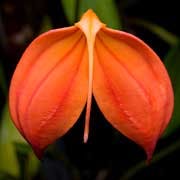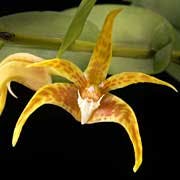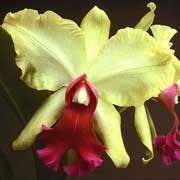I
ignea: Masdevallia ignea has fiery red flowers.

igneus, -a, -um Fiery color, red; igneous.
illustris, -e (ill-LUS-tris) Brilliant; lustrous.
imbricatus, -a, -um (im-bree-KAY-tus) Overlapping, like shingles on a roof, either vertically or spirally; imbricate.
immaculatus, -a, -um (im-mak-yew-LAY-tus) Spotless; immaculate.
immarginate (im-MAR-ji-nayt) Without a rim or edge; lacking a definite margin.
immersus, -a, -um (im-MER-sus) Entirely under water.
imperfect: This female flower of Cycnoches cooperi is imperfect because it has no pollen.

imperfect (im-per-fekt) Said of a flower that has either stamens or pistils but not both.
implexus, -a, -um (im-PLEKS-us) Tangled; interlaced; implexuous.
impregnation (im-preg-NAY-shun) Fecundation or fertilization of the ovule by the pollen; also the infiltration of substances.
impressus, -a, -um (im-PRESS-us) Deeply nerved; furrowed or grooved as if by pressure.
inaequalis, -e (in-ee-KWAY-lis) Unequal; having unequal parts.
incanus, -a, -um (in-KAY-nus) Hoary; quite gray; incanescent; canescent.
incarnatus, -a, -um (in-kar-NAY-tus) Flesh-colored.
included (in-KLEW-ded) Not protruding from the surrounding segments.
incertus, -a, -um (in-SER-tus) Doubtful; uncertain.
incisus, -a, -um (in-SYE-sus) Deeply and irregularly cut; incised.
incorrect names (in-KOR-rekt nayms) Names that are not in conformity with all requisite provisions of the International Codes of Nomenclature.
incomputus, -a, -um (in-KOMP-tus) Unadorned.
incrassate (in-KRASS-ayt) Thickened.
incrassatus, -a, -um (in-krass-AY-tus) Thickened; incrassate.
incumbent (in-KUHM-bent) Resting or leaning upon another organ.
incurvus, -a, -um (in-KER-vus) Crooked, bent; curved inward.
indefinite (in-def-ih-nit) Very numerous, as above 20; see "definite."
indehiscent (in-dee-HISS-ent) Not opening by valves, etc.; remaining persistently closed.
indeterminate (in-dee-ter-min-it) Growing on from the apex, particularly of the main axis.
indigen (IN-di-jen) A plant that is indigenous or native.
indigenous (in-DIJ-en-us) Native to a country or region, not introduced.
indivisus, -a, -um (in-div-EYE-sus) Undivided.
indument (in-DEW-ment) Any pubescent or hairy covering
induplicate (in-DEW-pli-kayt) With margins folded inward.
induratus, -a, -um (in-dew-RAY-tus) Hard, hardened.
inferior (in-feer-EE-or) Beneath, lower, below; as an inferior ovary, one that is below the attachment of the petals and sepals.
inflatus, -a, -um (in-FLAY-tus) Blown up; bladdery; swollen; inflated.
inflexed (in-FLEXD) Bent or turned abruptly inwards or downwards.
inflorescence (in-floor-ESS-ents) The general arrangement and disposition of the flowers on an axis; the mode of flowering; the flowering part of a plant.
infra- (IN-frah) In combinations, signifying "below."
infundibuliformis, -e (in-fund-dib-yew-li-FORM-is) Funnel-form, trumpet-shaped; infundibuliform.
infundibulum (in-fun-DIB-yew-lum) A funnel.
innate (in-nayt) Borne at the apex of the supporting part.
inodorus, -a, -um (in-oh-DOOR-us) Scentless; without a scent.
inscriptus, -a, -um (in-SKRIP-tus) Marked, as if with letters; inscribed.
insecticide (in-sekt-ih-SIDE) The class of chemicals that is used to attack insects.
inserted (in-sir-ted) Attached; as a stamen growing on the corolla.
insignis: Dendrobium insigne is distinguished.

insignis, -e (in-SIG-nis) Noble, admirable, distinguished.
inter- (in-ter) Prefix meaning between.
interfoliaceous (in-ter-foll-EE-AY-shuss) Between the leaves of a pair.
intergeneric (in-ter-jen-NAIR-ik) Between or among two or more genera.
integer, -gra, -grum (IN-tej-er) Entire.
intermedius, -a, -um (in-ter-MEE-dee-us) Halfway between two other things; intermediate in color, form or habit.
internode (IN-ter-nohd) That portion of a stem between two nodes or joints.
interruptus, -a, -um (in-ter-RUPP-tus) Not continuous, as with scattered leaves or flowers; interrupted.
interspecific (in-ter-speh-SIFF-ik) Between or among two or more species.
intortus, -a, -um (in-TORT-us) Twisted upon or around itself.
intra- (in-tra) A prefix meaning within.
intramarginal (in-tra-mar-GIN-ahl) Just within the margin or edge; between the margins.
introduced (in-truh-doosd)) Brought from another region, either intentionally or otherwise; in horticulture, used to designate the intentional bringing of plants into cultivation either from another country or from the wild.
introduction (in-tro-DUK-shun) An exotic plant introduced by man or other agency from its native region to another area.
introrsus, -a, -um (in-TROR-sus) Turned or faced inward or toward the axis; introrse.
inverted (in-vuhr-ted) Turned over; end-for-end; topside down.
in vitro (in-VEE-tro) Biological processes and reactions under artificially controlled conditions outside of the organism.
in vivo (in-VEE-vo) Biological processes and reactions within a living organism.
involute (IN-vo-loot) Rolled inward or toward the upper side; said of a flat body (as a leaf) See "revolutus."
Ionopsis (eye-oh-NOP-siss) A genus of two tropical and subtropical American orchids, usually epiphytic, described in 1815 by Humboldt, Bonpland and Kunth, the name referring to the violet-like appearance of the flowers.
Ipsea (IP-see-ah) A monotypic genus from Ceylon and southern India, related to Phaius. It was described by Lindley in 1831, the origin of the name obscure but probably meaning "by itself," that is, without close relatives; the sole species, the yellow-flowered Ipsea speciosa, is called the "daffodil orchid."
iridifolius, -a, -um (eye-rid-i-FOH-lee-us) Iris-leaved.
irregular (ih-REG-yuh-lar) Showing inequality in the size, form or union of its similar parts.
irroratus, -a, -um (ir-ror-AY-tus) Dewy; moistened, sprinkled with dew; irrorate.
Isabelia (iz-a-BELL-ee-ah) A monotypic genus of dwarf-growing creeping epiphytic orchids from Brazil, now referred to as Neolauchea. Related to Sophronitis, it was founded by Barbosa-Rodrigues in 1877, the name honoring Isabel, Countess d'Eu, partroness of science and floriculture in Brazil under the reign of Pedro II.
Isochilus (eye-soh-KYE-lus) A genus of 10 species of tropical American epiphytes allied to Ponera, described by Robert Brown in 1813, the name alluding to the fact that the lip is usually equal to the sepals in size.
Isotria (eye-SOH-tree-ah) A genus described by Rafinesque in 1808 consisting of two species of terrestrial orchids confined to the United States, the name referring to the symmetrical arrangement of the three sepals that are similar in size and shape.
isozyme (eye-so-zyme) Different forms of the same enzyme that have slightly different activities; used in chemotaxonomy.
isthmus: Rlc. Malvarosa Jade has an isthmus lip.

isthmus (IS-muhs) A narrowed portion of a part or segment of a flower.
ixioides (iks-ee-OY-deez) Resembling plants of the African genus Ixia in the Iridaceae.








